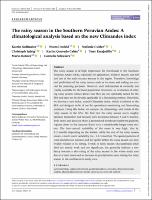Mostrar el registro sencillo del ítem
The rainy season in the Southern Peruvian Andes: A climatological analysis based on the new Climandes index
| dc.contributor.author | Sedlmeier, Katrin | |
| dc.contributor.author | Imfeld, Noemí | |
| dc.contributor.author | Gubler, Stefanie | |
| dc.contributor.author | Spirig, Christoph | |
| dc.contributor.author | Quevedo Caiña, Karim | |
| dc.contributor.author | Escajadillo Fernandez, Yury | |
| dc.contributor.author | Rohrer, Mario | |
| dc.contributor.author | Schwierz, Cornelia | |
| dc.date.accessioned | 2023-02-28T17:10:13Z | |
| dc.date.available | 2023-02-28T17:10:13Z | |
| dc.date.issued | 2023-01 | |
| dc.identifier.uri | https://hdl.handle.net/20.500.12542/2654 | |
| dc.description.abstract | The rainy season is of high importance for livelihoods in the Southern Peruvian Andes (SPA), especially for agriculture, which is mainly rain fed and one of the main income sources in the region. Therefore, knowledge and predictions of the rainy season such as its onset and ending are crucial for planning purposes. However, such information is currently not readily available for the local population. Moreover, an evaluation of existing rainy season indices shows that they are not optimally suited for the SPA and may not be directly applicable in a forecasting context. Therefore, we develop a new index, named Climandes index, which is tailored to the SPA and designed to be of use for operational monitoring and forecasting purposes. Using this index, we analyse the climatology and trends of the rainy season in the SPA. We find that the rainy season starts roughly between September and January with durations between 3 and 8 months. Both onset and duration show a pronounced northeast-southwest gradient, regions closer to the Amazon Basin have a considerably longer rainy season. The inter-annual variability of the onset is very high, that is, 2–5 months depending on the station, while the end of the rainy season shows a much lower variability (i.e., 1.5–3 months). The spatial patterns of total precipitation amount and dry spells within the rainy season are only weakly related to its timing. Trends in rainy season characteristics since 1965 are mostly weak and not significant, but generally indicate a tendency towards a shortening of the rainy season in the whole study area due to a later onset and an increase in precipitation sums during the rainy season in the northwestern study area. | es_PE |
| dc.description.sponsorship | El trabajo fue financiado por la Agencia Suiza para el Desarrollo y la Cooperación (COSUDE). | es_PE |
| dc.format | application/pdf | es_PE |
| dc.language.iso | spa | es_PE |
| dc.publisher | John Wiley and Sons | es_PE |
| dc.relation | CLIMANDES | es_PE |
| dc.relation.uri | https://rmets.onlinelibrary.wiley.com/doi/full/10.1002/joc.8013 | es_PE |
| dc.rights | info:eu-repo/semantics/openAccess | es_PE |
| dc.rights | Atribución-NoComercial-SinDerivadas 3.0 Estados Unidos de América | * |
| dc.rights.uri | http://creativecommons.org/licenses/by-nc-nd/3.0/us/ | * |
| dc.source | Repositorio Institucional - SENAMHI | es_PE |
| dc.source | Servicio Nacional de Meteorología e Hidrología del Perú | es_PE |
| dc.subject | Climatología | es_PE |
| dc.subject | Andes | es_PE |
| dc.subject | Lluvia | es_PE |
| dc.subject | Agroclimatología | es_PE |
| dc.subject | Agricultura | es_PE |
| dc.title | The rainy season in the Southern Peruvian Andes: A climatological analysis based on the new Climandes index | es_PE |
| dc.type | info:eu-repo/semantics/article | es_PE |
| dc.identifier.doi | https://doi.org/10.1002/joc.8013 | |
| dc.subject.ocde | https://purl.org/pe-repo/ocde/ford#1.05.09 | es_PE |
| dc.subject.sinia | precipitacion - Clima y Eventos Naturales | |
| dc.type.sinia | text/publicacion cientifica | |
| dc.identifier.url | https://hdl.handle.net/20.500.12542/2654 | |
| dc.identifier.url | https://hdl.handle.net/20.500.12542/2654 |
Ficheros en el ítem
Este ítem aparece en la(s) siguiente(s) colección(es)
-
Artículo científico [171]









